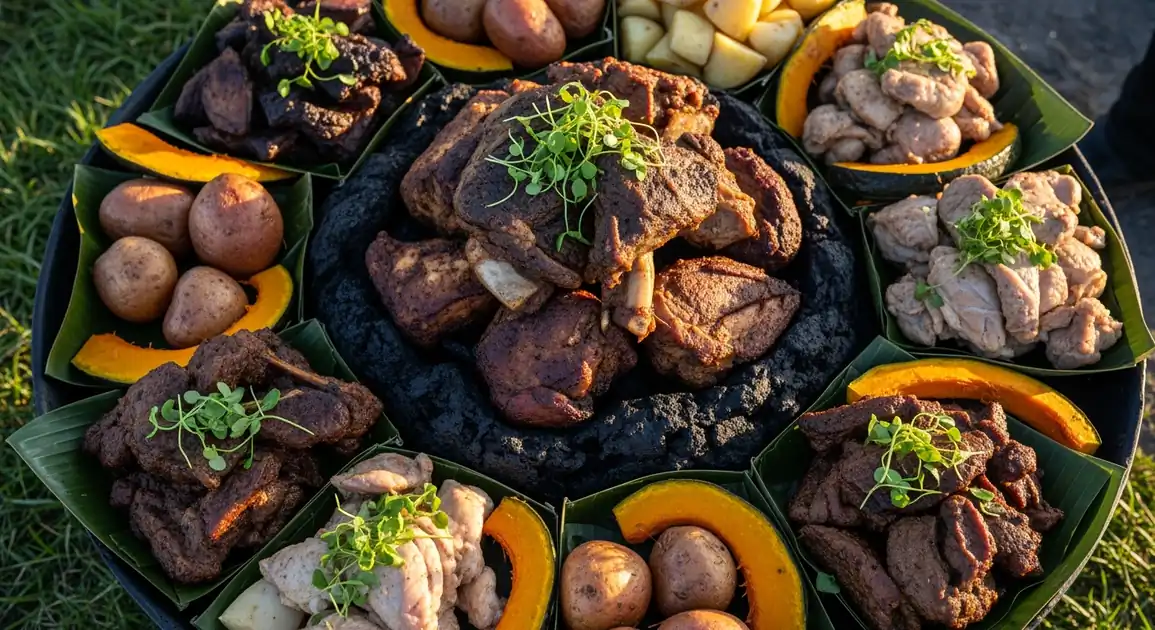Hangi
Hāngī

Description
As New Zealand's largest city, Auckland offers both commercial hangi experiences catering to tourists and more authentic community events through local marae (meeting grounds) and cultural centers. Urban hangi adaptations include above-ground cookers for regulatory compliance, though some venues maintain traditional methods for special occasions.
Dietary Information
Serving information
Serving style
Urban hangi experiences often use individual plating rather than traditional communal serving. Standard portions typically include 2-3 meat options and 3-4 vegetable varieties.
Quick facts
Commercial experiences typically run 6 PM - 9 PM. Community events more variable, often midday (11 AM - 2 PM) on weekends.
Safety Tips
What to Look For
-
Experienced hangi masters overseeing the process
Proper hangi requires specific knowledge of cooking times, temperatures, and techniques. Experienced practitioners ensure food safety and quality.
-
Steam rising when hangi is uncovered
Visible steam indicates the food has reached and maintained proper cooking temperature throughout the process.
-
Meat that falls off the bone easily
Properly cooked hangi meat is very tender. Resistance when pulling meat apart can indicate undercooking, particularly concerning for chicken and pork.
-
Food served hot immediately after unearthing
Properly cooked hangi should be served promptly after uncovering to maintain safe temperatures and prevent bacterial growth.
-
Clean, food-grade wrapping materials
Traditional leaves or modern foil/cloth should be clean and suitable for food contact to prevent contamination.
What to avoid
-
Pink or bloody meat, especially chicken or pork
Meat should be thoroughly cooked with no pink remaining, particularly for chicken and pork to avoid foodborne illness.
-
Undercooked vegetables (especially potatoes)
Hard vegetables indicate insufficient cooking time/temperature, suggesting the entire hangi may be undercooked.
-
Cold spots in the food
Uneven temperatures can indicate problems with the cooking process. All portions should be consistently hot.
-
Hangi that's been held at room temperature for extended periods
Food should be served promptly after unearthing. Extended holding at ambient temperature can allow bacterial growth.
-
Restaurants claiming 'hangi' but using conventional ovens
While not a safety concern, conventional oven cooking lacks the authentic flavor and may not reach the same cooking temperatures as traditional methods.
Price information
Price range
Budget tips
- Cultural events at local marae occasionally open to the public offer affordable authentic experiences (NZ$30-45).
- Auckland Night Markets sometimes feature smaller hangi portions at lower prices (NZ$15-20).
- Outer suburb venues tend to be more affordable than central city options.
- Look for community fundraisers which often include hangi at reasonable prices.
Value indicators
- Involvement of local iwi (tribes) such as Ngāti Whātua.
- Traditional cooking methods rather than steam-cooker adaptations.
- Cultural performance or educational component included.
- Opportunity to view part of the preparation process.
- Multiple protein options (lamb, pork, chicken) rather than just one meat.
Where to Find This Dish
West Auckland
Stronger Māori community presence with more authentic offerings.
Te Taumata Kawa Marae (Henderson), Hoani Waititi Marae (Glen Eden)
Weekend midday, Special events
Central Auckland
Commercial operations catering primarily to tourists.
Auckland Domain, Auckland Museum cultural experiences
Evening (6 PM - 8 PM)
South Auckland
Community events and cultural celebrations featuring hangi.
Manukau and Mangere community centers, Ōtara Markets (special events)
Weekend midday, Festival days
Vendor Tips
- Ask if the hangi is prepared by local iwi members for authenticity.
- Urban regulations sometimes restrict traditional in-ground cooking - ask about their methods.
- Community events advertised through local marae social media often provide more authentic experiences than commercial operations.
How to Order
Regional Variations
-
Urban Steam-Cooker Hangi
(Hāngī Tāone)
Modified method using above-ground equipment to comply with city regulations prohibiting earth ovens in many areas.
-
Pan-Pacific Hangi
(Hāngī Moana-nui-a-Kiwa)
Reflecting Auckland's diverse Polynesian community, some hangi incorporate elements from other Pacific cooking traditions (Samoan umu, Tongan lovo).
Cultural context
History
Hāngī has been a cornerstone of Māori cooking for over 700 years, brought to Aotearoa (New Zealand) with Polynesian settlers. Traditionally used for communal cooking at important gatherings, the technique maximized fuel efficiency while producing large quantities of food. Special pit sites became established at marae (meeting grounds) for regular use. While historically wrapped in leaves from native plants like harakeke (flax), modern adaptations often use foil and cloth. Despite contemporary conveniences, many communities maintain traditional methods for cultural preservation.
Local significance
In urban Auckland, hangi maintains cultural importance while adapting to city regulations and space limitations. It serves as a connection to heritage for urban Māori and an introduction to indigenous culture for immigrants and visitors.
Eating customs
- Commercial experiences may present food in a more restaurant-style manner.
- Urban versions still emphasize the communal aspect of sharing food together.